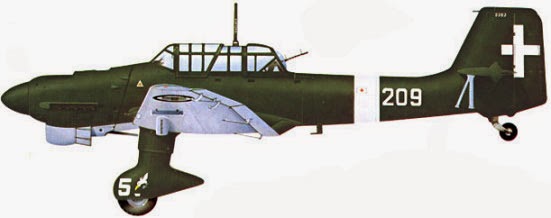Ju.87B-2 Unit: 208 Squdriglia, 97 Gruppo Bombardamento a Tuffo Serial: 208 Sicily, in 1942.
Ju.87B-2 Unit: 236 Squdriglia, 96 Gruppo Gruppo Bombardamento a Tuffo Serial: no codes (W.Nr.???)
Comiso (Ragusa), Sicily, September 1940. Originally, 96 Gruppo was to have been equipped with the Savoia-Marchetti SM.85, a dive bomber that turned out to be totally unsuitable and was replaced by the Ju.87B. The machines initially came from Luftwaffe stocks and their German markings had to be painted over using Verde Oliva Scuro 2 and Grigio Azzurro Chiaro 1 and replaced by the fasces and white cross of their new owners. (Camouflage: RLM70 Schwarzgrun / RLM71 Dunkelgrun upper surfaces with RLM65 Hellblau undersides).
Ju.87B-2/Trop Unit: 209 Squdriglia, 97 Gruppo Autonomo Bombardamento a Tuffo Serial: 209-5 (W.Nr.???)
Gars-el-Arid, Libya, September 1941.
The battles of France and Britain had shown the Ju 87 to be exceptionally vulnerable to fighter opposition, but the type nevertheless continued to perform useful service in the Mediterranean and North Africa with the Italians. The Stuka was widely used by all the Axis Air Forces, including those of Italy, Hungary, Slovakia, Romania and Bulgaria. The overall dark green upper surfaces seen here replaced the standard Luftwaffe two-tone disruptive splinter scheme of previous machines. However, this extreme is some-times very difficult to confirm in period black and white photographs. (Camouflage: RLM71 Dunkelgrun upper surfaces with RLM65 Hellblau under-sides).
Ju.87R-2 Unit: 208 Squdriglia, 101 Gruppo Autonomo
Bombardamento a Tuffo Serial: 208 North Africa, 1942.
Bf.110C Unit: unknown Serial: 235+6 Night Fighter
Do.217J-1 Unit: 235 Squadriglia, 60 Gruppo, 41 Stormo
Serial: 235-8 Treviso San-Giuseppe, winter 1942-1943. Note: White Balkenkreuze
above and below wings; Swastika on fin painted over.







No comments:
Post a Comment